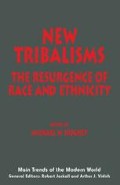Abstract
Social thinkers in the 20th century devoted their attention primarily to issues of economic class. The great experiments of this century with communism and welfare state liberalism were intended to rationally manage the problems associated with class inequalities, either by softening the inequities created by capitalism or by attempting to eliminate class altogether. In this focus, the more primordial bonds of racial, ethnic, and nationalist loyalties and identities were often regarded as irrational anachronisms that would either be submerged under the imposed orthodoxy of communism or, more benignly, dissolved within the liberal frameworks of constitutional democracies. Yet, today, communism is nearly dead, liberalism is on the wane, and the older ethno-racial tribalisms, as well as some newly invented ones, have seemingly everywhere broken through our illusions of a rationally manageable world to find expression in chauvinistic nationalisms, “multiculturalist” ideologies, vicious civil wars, “ethnic cleansing” of whole regions, intensified racial and ethnic strife, a resurgence of racism, prejudice, scapegoating, hate groups, and nativism in almost all societies, and new group-based challenges to the individualistic focus of Western liberalism. It appears increasingly likely that as the 20th century draws to a close it will bequeath an urgent preoccupation with these new tribalisms to its successor.
Access this chapter
Tax calculation will be finalised at checkout
Purchases are for personal use only
Preview
Unable to display preview. Download preview PDF.
Notes
W. E. B. DuBois, The Souls of Black Folk (New York: Fawcett World Library, 1961 [1903]), p. 23.
Gunnar Myrdal, An American Dilemma: The Negro and Modern Democracy (NY: Harper Collins, 1944). Talcott Parsons, “Full Citizenship for the Negro American? A Sociological Problem,” in Talcott Parsons and Kenneth B. Clark (eds), The Negro American (Boston: Houghton Mifflin, 1966).
Robert E. Park, Race and Culture (New York: The Free Press, 1950).
J. Hector St John Crevecoeur, Letters From An American Farmer (New York: Albert and Charles Bon, 1925). See also Israel Zangwill, The Melting-Pot (New York: Macmillan, 1911);
Frederick Jackson Turner, The Frontier in American History (New York: Henry Holt & Co., 1920).
Horace Kallen, Culture and Democracy in the United States (New York: Arno Press and the New York Times, 1970 [1924]).
Randolph Bourne, “Trans-National America” and “The Jew and Trans-National America,” both reprinted in Bourne The War and the Intellectuals: Collected Essays, 1915–1919, ed. by Carl Resek (New York: Harper and Row, 1964).
Winant refers to Asian-Americans as an example of a newly created ethno-racial identity. Hispanics also constitute an ethnic category forged in the post-Civil Rights era. See Patricia Kolb, “The Development of the Pan-Hispanic Community in the United States,” in Michael W. Hughey and Arthur J. Vidich (eds), The Ethnic Quest for Community: Searching for Roots in the Lonely Crowd (Greenwich,: CT:JAI Press, 1993).
Arthur M. Schlesinger, The Disuniting of America (New York: Norton, 1992).
Herbert J. Gans, “Symbolic Ethnicity: The Future of Ethnic Groups and Cultures in America,” Ethnic and Racial Studies, 2(1) (January 1979) 1–20.
See Ann Swidler, “Culture as Action: Symbols and Strategies,” American Sociological Review, 51 (1986) 273–86.
Classes: Irish and Italians in Queens and Brooklyn," in Michael W. Hughey and Arthur J. Vidich (eds.), The Ethnic Quest for Community: Searching for Roots in the Lonely Crowd (Greenwich, CT: JAI Press, 1993).
Waters as well as by Richard Alba, Ethnic Identity: The Transformation of White America (New Haven, CT: Yale University Press, 1990).
Benjamin R. Barber, “Global Multiculturalism and the American Experiment,” World Policy Journal, 10(1) (Spring 1993) 47–55.
Editor information
Editors and Affiliations
Copyright information
© 1998 Michael W. Hughey
About this chapter
Cite this chapter
Hughey, M.W. (1998). Introduction. In: Hughey, M.W. (eds) New Tribalisms. Main Trends of the Modern World. Palgrave Macmillan, London. https://doi.org/10.1007/978-1-349-26403-2_1
Download citation
DOI: https://doi.org/10.1007/978-1-349-26403-2_1
Publisher Name: Palgrave Macmillan, London
Print ISBN: 978-0-333-66666-1
Online ISBN: 978-1-349-26403-2
eBook Packages: Palgrave Social & Cultural Studies CollectionSocial Sciences (R0)

